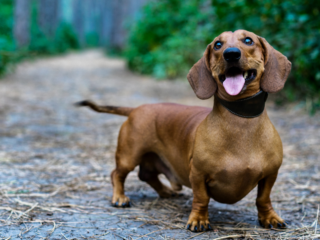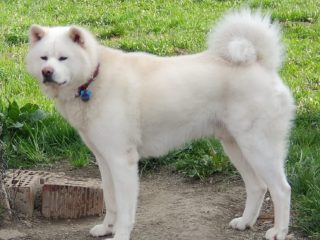I have a good friend who owns a Dachshund and I have to say that one of the most adorable and most expressive things about her dog is his tail! Her Dachshunds tail is like an extension of his personality coming out of his long thin body.
A little waving stick on the end of her cute Dachshund hot dog-looking frame.
When her Dachshund was having problems with biting its tail she asked me for advice I decided that I wanted to not only share that information with her but with anyone else that may need it as well.
So I took a minute to paws and learn everything I could about a Dachshunds tail! Here are all the answers you may need about your cute Doxies tail!
What does a Dachshund Tail Look Like
A normal Dachshund’s tail extends out from the spine in a straight line and slightly arching upward from its back. Its thickest point is from the rear end of your Dachshund and it should slowly taper to a point. The hair on its tail is long and sleek, but maybe a bit thicker than elsewhere on its body.
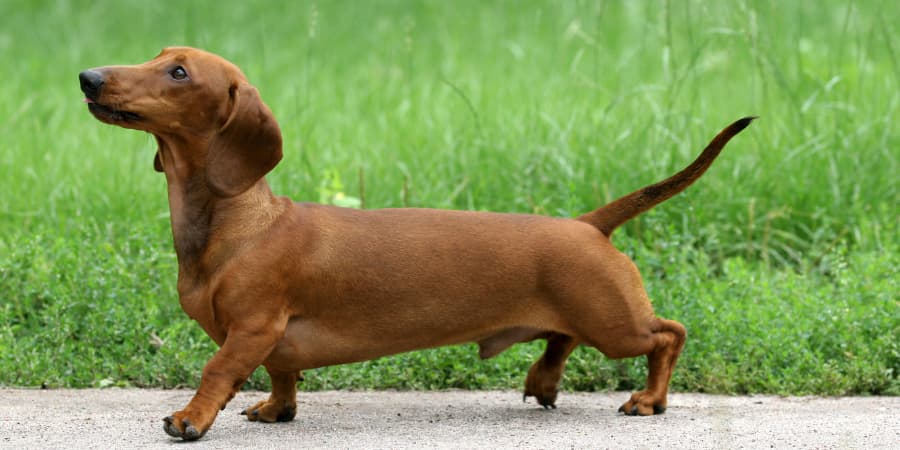
A purebred Dachshund should have a long straight tail. If there are twists or kinks in the tail that could indicate a genetic flaw. Twists or kinks could also be from a previous injury to the tail.
Pro Tip: If you are interested in the best grooming tools for your dog you can find them by clicking here now!
Disclaimer: This post may contain affiliate links. We only recommend high-quality products that are used and recommended by real owners. If you use these links to buy something we earn a small commission.
How long are Dachshund Tails?
Dachshunds Tails on average are 8 to 9 inches long with some being as long as 10 inches. Miniature Dachshund tails range from 4-9 inches with an average length of around 6 inches.
I like to say just long enough to be adorable, expressive, and a little bit dangerous.
Kerri R.
When they get excited wagging those long thin tails watch out! It’s like their own personal whip!
Do Dachshund get their tails docked
Dachshunds are not a breed that gets their tails docked. Their tail should be long and remain the natural length they are born with. On rare occasions, a vet may recommend docking a tail if your Dachshund has severely injured it or it has a severe infection and it’s in the best interest of the dog’s health.
Tail Docking or bobbing is the removal of portions of a dog’s tail. Historically tail docking was done to prevent injury for working dogs.
This is interesting to me because Dachshunds are historically working dogs and have even been called badger dogs because they were used to hunt badgers and other small rodents or prey. Knowing this we might wonder why Dachshunds didn’t historically have docked tails like other hunting dog breeds such as Yorkies or Jack Russell Terriers.
I have come to find out that hunters actually found their tails on their Dachshunds to be helpful and would use them as leverage to pull their dogs out of holes or burrows that they may have gotten stuck in while hunting.
The other reason why hunters left their dog’s tail long was to help them see their dog in the long grass. As their Dachshunds hunted and sniffed through the long grass their long tails would wag and move the grass back and forth and it would help their owner tell where they were.
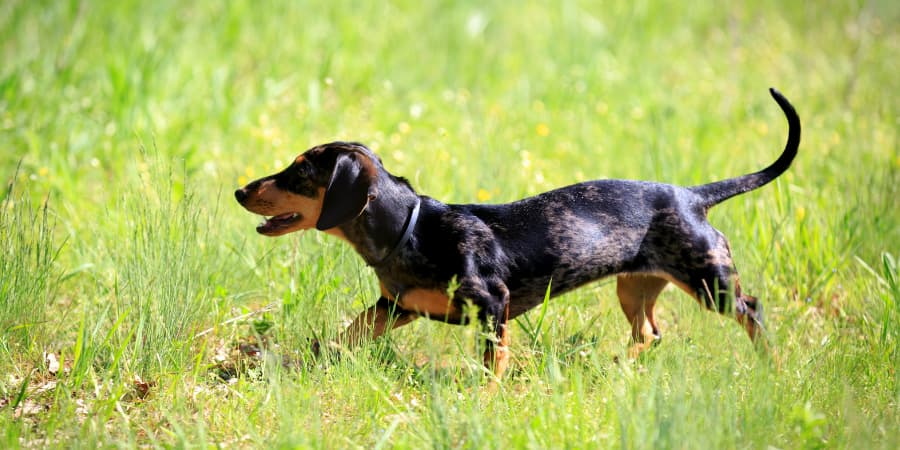
Do Dachshunds have curled tails?
Dachshunds do not have curly or curled tails. Their tails are long and straight and should arc up slightly. If your Dachshund has a kink or curl in its tail it could be a sign of a genetic flaw or an injury.
If your Dachshund’s tail curls up and over its body or it has a curly tail this could be a sign that your Dachshund might not be purebred. A purebred Dachshund will have a long straight tail that extends out from its body and slightly curves upwards.
Dachshund Tails Problems and Solutions
If you have noticed that your Dachshund is acting abnormally by not wagging its tail as enthusiastically as it used to, or its tail is hanging down between its legs it could be quite alarming. Seeing our loving pets in pain or noticing something might be wrong can be scary.
Consulting with your vet should always be your first step, but if you are left waiting for a day or two before your furry friend can be seen read on for some additional information to ease your mind.
Pro Tip: If you are not able to get a hold of a vet near you, or you want to avoid an unnecessary ER trip, there are online resources that you can turn to. Here is our best recommendation:
Pawp: a 24/7 digital clinic for pets that connects you to an experienced vet
Why we love it:
🐾 Answers 24/7! 🐾 No waiting! 🐾 Get Answers Online with Local Vets! 🐾 Quick Response Time! 🐾 Easy Sign UP!
Try Pawp 7 Days For Free
Dachshund Tail Hanging Down
If your dog is temporarily holding its tail in the down position it’s most likely an indication of submission or guilt, but if your Dachshund is unable to hold its tail upright as it has in the past and it seems as if it’s in pain it could indicate a condition called limber tail or possible IVDD (Intervertebral disk disease).
Here is a list of other things that Dachshund owners have said cause tail issues in their dogs. We will go into more detail below.
- Anal Glands
- IVDD
- Constipated
- Injury or Broken Tail
- Limber Tail (Swimmers Tail)
Anal Glands
If you notice your Dachshund chasing its tail a lot more than usual or scooting its bum across the carpet it could be that its anal glands are blocked and swollen.
Sometimes it’s as simple as our Dachshunds anal glands needing to be expressed. You can have your vet do it, or learn to do it yourself.
For more information on this, you can read this article on Wag Walking.
IVDD in Dachshunds
Another somewhat serious problem that can cause tail discomfort in Dachshunds is a back issue known as IVDD. The technical term for this is Intervertebral disk disease (IVDD) it can also be described as a ruptured, slipped, bulging or herniated disk in your dog’s neck or back.
This type of back issue is fairly common in Dachshunds. Quite a few owners that I talked with have had this issue with their dogs. Some have been able to help their dog feel better with resting and medication, some have had to get their Doxies operated on.
Here is a good resource to look at if you feel like this might be your doxies problem.
Dachshund Broken Tail
Dogs do have bones in their tails and they can if injured badly enough break. Since Dachshund’s tails are so long and thin you will need to be extra careful with your dog’s tail not to injure it or get it caught in something like a door or a sharp object.
If you think your dog has a broken tail it is important that you take them to your vet.
Signs of a broken tail include swelling, bending, and a kink in the tail. Your dog might have difficulty moving or wagging its tail or are holding it in an unusual position.
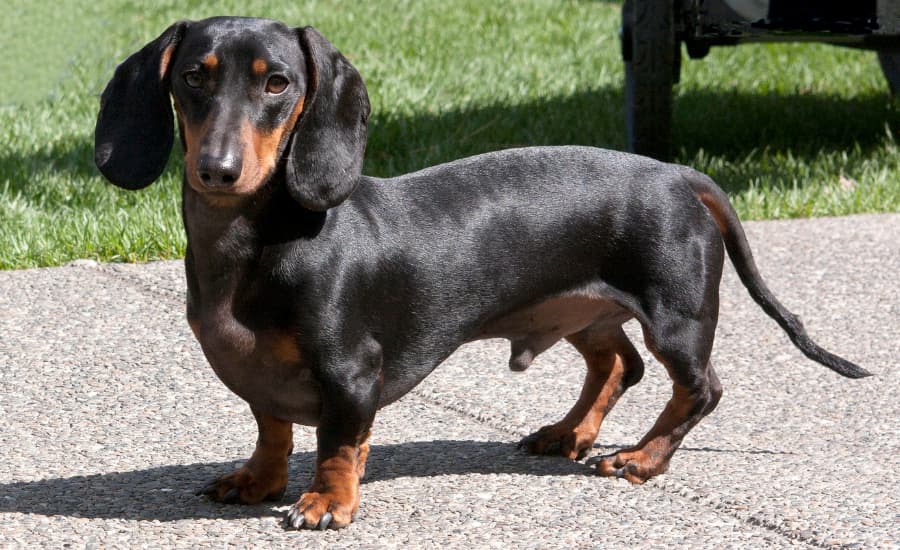
Dachshund Chasing its Tail or Biting its Tail
For the most part, if your dachshund is chasing its tail it’s most likely just a harmless and adorable game. Puppies tend to do this a lot because they are so playful and explore more about their world while discovering their fun long tails. If your dog is chasing his tail it might be because he’s bored or it’s just a fun game for him.
Trying out a fun training program together like this widely popular program Brain Training for Dogs can help unlock your dog’s hidden potential and help them learn how to avoid problem behaviors.
The problem comes when your dog is obsessively chasing its tail and it seems like they are in pain stressed or biting its tail and causing things like bleeding, or hair loss.
If this is the case then rightfully you are probably concerned.
The cause for this could be one of several things. Here are the things that you can look for.
- Impacted anal glands
- Parasites like fleas or ticks in the tail
- Injury or sharp pain somewhere on the tail
- Allergies or itchy skin
What is Limber (Swimmers) Tail In Dachshunds and What to Do
If you notice your Dachshunds tail hanging down and it looks limp and unnatural then he may have a condition known as Limber Tail.
Limber tail Also known as swimmer’s tail, frozen tail, dead tail, broken wag, or cold tail is a condition that causes your dog to hold his tail limp and down instead of the usual upright position. Its official name is Acute Caudal Myopathy.
It is most likely to happen after your dog has had very active or strenuous play, exercise, or excessive tail wagging. Sometimes a lot of swimming can cause it, being in cold wet weather, if they are confined to their crate too long, or if your dog’s tail is wagging and getting whacked on various surfaces.
This could cause your dog pain and swelling in their tail, making it difficult to sit. Usually, this condition will go away on its own after a few days of rest. It’s important to try and limit exercise and movement if you notice that your dog is experiencing this problem. If it is causing your dog a lot of pain then consulting your vet is a good idea.
Usually, this isn’t a chronic problem, but it is a good idea to figure out what may have triggered it in the first place and try to avoid that activity if possible. Coldwater play, or being confined in a crate too long are often things that could trigger this condition.
Dachshund Tail Infection (Tail Tip Necrosis)
This is a very serious problem, but thankfully very rare in Dachshund. It can be important though that you learn to identify it right away so the issue can be dealt with before it causes permanent damage.
This can be caused by the constant beating of the tail against objects that may harbor bacteria. If the tail gets an open wound and the bacteria gets in it can lead to an infection that will spread and cause the tissue to become damaged or start dying.
Watch for hair loss at the end of the tail. Excessive itching, bloody or brittle skin, foul-smelling, excessive biting of the tail.
Take your dog to the vet right away if you notice any of these things in your dog. The vet will assess and most likely have to amputate the infected part of the tail. This may be a very sad thing to have to deal with, but if the infection spreads it could endanger your dog’s life.
Dachshund Tail Fun! The Trash Can Song!
Like I said in the beginning our Doxies tails can be the cutest part of them sometimes. It may just make you want to celebrate!
Also, check out this adorable Dachshund clock!
Dachshund Tail Wagging and Communication
Dachshunds wag their tails for many different reasons. It’s a big part of how they communicate with you. Wagging their tail doesn’t always mean they are happy. They could be conveying other emotions like nervousness or fear as well. The key to understanding their tail wags is to put it together with all the other contextual clues they are giving you. What are their ears doing, their eyes, how is their posture? Noticing these things as well will help you know why your Dachshund is wagging their tail.
Here are some things your Dachshund could be communicating to you with its tail.
- Calm and chill – Tail in the natural resting position. Sleeping or resting or casually walking around.
- Greeting or I love you – Usually, a big carefree wag, accompanied by eye contact, coming to you and jumping on you or trying to get your attention.
- Curious or unsure – Backwards and gentle wagging. Maybe sniffing around a little, intense and curious staring. Looking to you for reassurance.
- I’m nervous or scared – The tail between their legs and possibly slightly moving. Body tense, eyes down, ears laid back. Could also be trying to communicate a submissive position.
- Aggression – Tail high in the air and rigid. Poised, rigid, and making eye contact. Could be barking or growling as well.
- Happy and Excited – Fast care-free wagging. Wiggling body, happy facial expressions. Body not tense, possibly going in circles around the object causing excitement such as a treat or toy.
There’s also been a study done that shows the direction that your dog wags its tail can show positive or negative emotion.
Fun Fact: Wagging their tail towards the right side of their body can indicate more positive emotions such as relaxed, and happiness. Wagging their tails on the left side of their body is a sign of more negative emotions such as nervousness or fear.
Some dogs are bigger tail-waggers than others. If your dog doesn’t wag its tail a lot it’s most likely nothing to be worried about. You will just need to work on identifying other body language cues to help you understand what they are trying to tell you.
If your Dachshund has recently stopped wagging their tail then that could mean that there is something else going on. If you have just moved, or they are new to your home this could just mean they are nervous and need some time to get acclimated to their new environment.
Long Hair Dachshund Tail Guide and Grooming
Long Hair Dachshunds take a little more grooming and care than their short hair counterparts. A long hair Dachshunds
Generational genetics play a large part in the development of size, color, coat texture, etc. That is why established breeders who have show quality Dachsund’s do a lot of research and are very particular in pairing males and females and is the reason their offspring are so expensive. Coats of Long Hair Dachshunds mature up to two years.
Pro Tip: Having a grooming kit at home can help you maintain your dog’s beautiful coat and keep their tail looking nice and tangle-free! Here’s one that we really like. (We use it for our Maltese/Chi Mix)
Regardless of the cut that your long hair dachshund gets, usually, the tail is just brushed out and trimmed. It’s really up to you how long or short you want your dog’s long silky hair to be.
Most long hair Dachshunds have a gorgeous flag tail with the hair on the end of the tail a little bit longer which makes it look like a hanging flag.
If your Dachshund does get mats in their tail it’s probably a good idea to trim it up or possibly thin it out a little bit. Here is a video that will help you know how to trim your long hair Dachshunds tail.
Check out these other articles all about your Dachshund!
Obsessive Licking in a Dachshund, is it Normal? (Owners Tell All!) | Paws and Learn
Why Does My Dachshund Eat Everything? (Grass, Poop, Dirt, Sticks) | Paws and Learn
While we strive to give the most accurate and helpful information about your pet’s health that we can, this article is meant to be informational only and not medical advice. Never disregard, avoid or delay in obtaining medical advice from your veterinarian or other qualified veterinary health care provider regardless of what you have read on this site or elsewhere.


